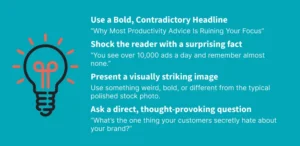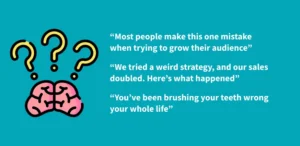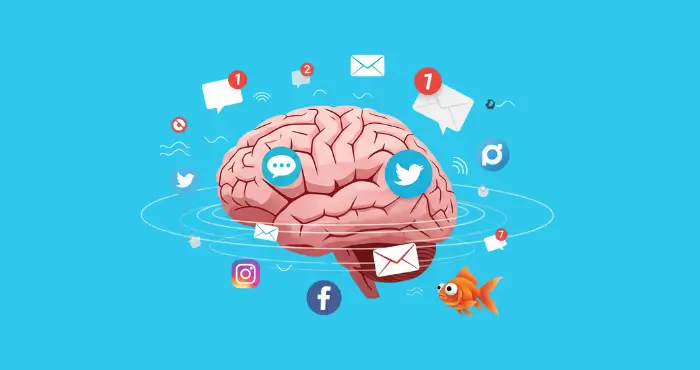According to research, our attention span is now shorter than a goldfish, making it harder to capture audience attention.
Every day, we’re bombarded with ads, emails, videos, and notifications all fighting for our focus.
Yet, we only pay attention to what feels urgent or relevant in the moment.
In the competitive and modern business landscape, understanding the critical role of attention in marketing is crucial.
Before you can sell a product, share a message, or tell a story, you must first earn it. This is how you capture audience attention.
This is the foundational principle of all successful campaigns.
Without it, the most brilliant strategy, persuasive copy, or perfect product remains unseen and unheard.
In today’s digital world, attention is more critical than ever.
The Psychology of a Distracted Mind: Why We Can’t Focus
If you want to win someone’s attention, you must understand how the brain handles information.
And here are three simple ways to look at it:
Cognitive Load:
Our brains have a finite amount of processing power, which makes it harder to capture audience attention.
When we are bombarded with information from multiple sources such as social media feeds, news alerts, emails, and ads, our cognitive load maxes out.
The brain’s defense is to aggressively ignore anything that isn’t immediately critical or highly engaging.
The Dopamine Loop:
Dopamine is a chemical in our brain that makes us feel good. It’s part of our brain’s reward system.
We get a slight boost of dopamine when we eat something tasty, receive a compliment, get a like on social media, or win a game.
Here’s how tech companies use this to get our attention:
They design their apps and websites to trigger immediate dopamine boosts.
For example, notifications like “Someone liked your post” or “You have a new message” grab our attention and make us curious.
Scrolling through reels on social media platforms also gives us something new to explore constantly.
This keeps our brain receiving dopamine, and over time, it can become a habit.
This constant craving for novelty creates a state of distraction.
It grabs our attention, but only if the content, like videos or reels, actually engages us enough to make us focus.
The Reticular Activating System (RAS):
The best way to grab attention and make people focus in this age of distraction is by using RAS, which stands for Reticular Activating System.
In simple language, imagine you’re at a loud party with thousands of people talking at once.
That’s like all the information coming at you every day, and you can’t listen to everything at once.
In fact, you’ll be overwhelmed. But that’s where savvy marketers use this effective strategy.
They use RAS to divert your attention toward their offer. They stop throwing random messages at people. Instead, they:
- Use your name (like in emails or ads)
- Mention things you already care about
- Show messages that feel personal or relevant to your life
Clever marketing speaks directly to your RAS by being personalized, targeted, and aligned with your interests, so it gets noticed and remembered.
The Core Challenge of Gaining Attention in Marketing Today
An American scholar, Herbert A. Simon, said:
“A wealth of information creates a poverty of attention.”
Source: Designing Organizations for an Information-Rich World
It means that the more information there is in the world, the harder it becomes for any one thing to get noticed.
Aren’t we surrounded 24/7 by videos, ads, texts, memes, emails, and notifications?
Absolutely yes! So in today’s world, attention is the most valuable.
If you’re trying to market something, whether it’s a product or a service, or an idea, you’re not only competing with similar brands.
You are also competing with:
- A text from someone’s best friend
- A viral dog video
- The latest Netflix movie
- Social Media Scrolls
- Latest Breaking News
Your offer might be great, your website might be beautiful, and your emails might be perfectly written.
But if no one pays attention and no one gets engaged, then none of it matters.
To capture audience attention, your messaging must be relevant, personal, and immediately engaging.
It should speak directly to the part of the brain that decides what is worth noticing (like the RAS we talked about earlier).
5 Proven Strategies to Capture Audience Attention
So how do you grab your target audience’s attention, make them interested in your message, and break through the digital noise?
The key is to capture audience attention quickly and effectively.
You don’t do it by being louder. You do it by being smarter.
Here are five proven strategies to create scroll-stopping content and capture your audience’s attention.
Strategy #1: Master the Pattern Interrupt
Our brains are brilliant, aren’t they? They’re actually smarter than you think.
When we’re on our phones, scrolling through social media feeds, our brains are constantly looking for what’s familiar so they can ignore it.
Why?
Because when we see things we’ve seen a hundred times before, our brain filters them out. It doesn’t waste energy on them.
So how do you stand out as a marketer?
You break the pattern.
You interrupt the brain’s autopilot with something unexpected, something that makes people stop scrolling and think: “Wait! What is this?”
This is the core principle to capture audience attention when everyone else is being ignored.
Here are four powerful ways to break the brain’s patterns:

Strategy #2: Weaponize the Curiosity Gap
Great copywriters don’t give everything up front in their messaging.
Instead, they create an itch, a little tension in the mind that says, “I need to know the answer to this.”
This is called the curiosity gap.
How do you do it? You tease the answer but don’t reveal all the details right away.
You:
- Hint at a solution without explaining it
- Suggest a secret or strategy they haven’t heard yet
- Pose a puzzle or question that makes them want to read more
This triggers a mental loop. Your reader’s brain wants to close the gap and find the missing piece. That’s what drives the click, the scroll, the read.
For example:

See what’s happening?
You have to know what the mistake is, what the strategy was, or how you’re doing something wrong. That’s the itch.
The ultimate goal of the curiosity gap is to create just enough mystery to capture audience attention and make them…
lean in…
click through it…
and keep reading it.
and they will continue reading. Because they want to satisfy their curiosity,
Strategy #3: Make It Hyper-Personal
With the rise of AI, most brands, especially those that are looking for quick wins, are bombarding people with generic messaging.
These messages are especially entirely “we” focused and feel like a robot is explaining things and selling to them.
But when true marketers use personalized language, like “you” and “I,” it changes everything.
It makes your audience feel like you’re speaking directly to them, not just shouting to the crowd.
When a message is personalized, it becomes a pattern interrupt. It breaks through the usual noise and grabs attention.
Focus on your audience’s specific problems, struggles, and dreams.
Use their own language, words, and phrases they would say themselves.
For example:
- Instead of “We offer the best service,” say, “You deserve the best service.”
- Instead of “Our product helps customers save time,” say, “How much time could you save with this?”
- If your audience is busy parents, you might say, “Tired of juggling everything on your own?” or “Looking for a simple way to get more time with your kids?”
Make it clear that the message is meant for them only.
Strategy #4: Prioritize Clarity Over Cleverness
Many marketers try to be clever with their messaging, hoping they’ll stand out.
But in today’s digital world, where attention is minimal, confusing people is a quick way to lose them.
Why? Because when someone doesn’t understand your message right away, their brain hits the brakes and says:
“I don’t get it. Next.”
In the attention economy, a confused mind always says no.
So how do you stand out?
- Use simple language
- Use humor sometimes
- Use words an 8-year-old can understand
- Use short sentences, around 15 words each
Present your value proposition, which means what you offer and why it matters, in a way that people can understand in just a few seconds.
In short, clear beats clever every time.
If your audience has to work to understand you, you’ve already lost their attention.
To effectively capture audience attention, your message must be understood in seconds.
Strategy #5: Trigger an Emotional Response
We’ve heard most of the time that facts, stats, and product features are what drive decisions, but to capture audience attention, emotional connection must come first.
People buy things with emotion first, and later justify it with logic.
For example:
- How they buy with emotions:
“I just had to get the new iPhone. It looks so sleek, and I love how it feels in my hand.” - How they justify it with logic:
“Plus, the camera is way better for work, and I needed the storage upgrade anyway. It’s basically an investment.”
You’ve Captured Their Attention. Now, How Do You Hold?

Source: Giphy
Imagine you’re scrolling through your phone and suddenly a bold headline, or shocking news, a funny picture, or a cute dog captures your attention.
And the moment you pause for a second, it’s a small win for the marketer.
But if the content doesn’t give you what you expect, you’ll scroll away (I mostly do).
For example, you read the headline: “How to Read 10 Books a Day as a Busy Learner and Remember Them All with This Simple Method.”
You clicked because you’re curious. Now, the first thing you read must explain what the method is or at least begin answering the question.
But if you felt like it was clickbait, you’ll lose trust and leave.
When people feel like you’re being honest, helpful, and engaging, they’ll stay longer, keep reading, and actually care about what you’re saying.
To succeed in marketing, don’t just try to grab attention; earn it by being honest, helpful, and worth people’s time.
If your content helps people or makes them feel something, they’ll stay, listen, and maybe even come back for more.
This is the ultimate secret: to truly capture audience attention long-term, you must provide genuine value.
Always focus on how to capture audience attention first, because without it, everything else fails.
Once you’ve mastered how to capture audience attention in a distracted digital world, the next step is keeping it, especially when your audience is comparing you to competitors.
That’s where the Marketing Inoculation Method comes in.

